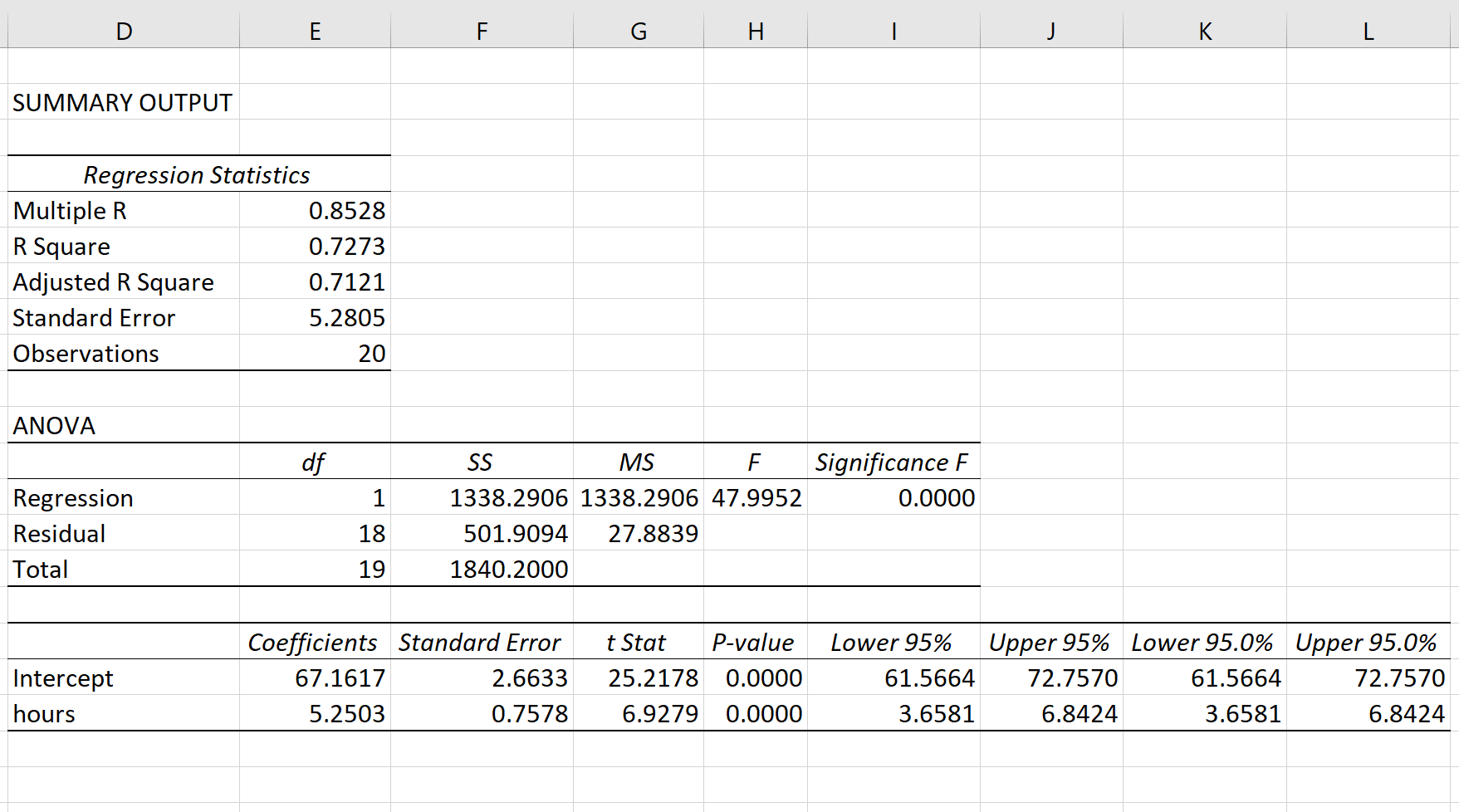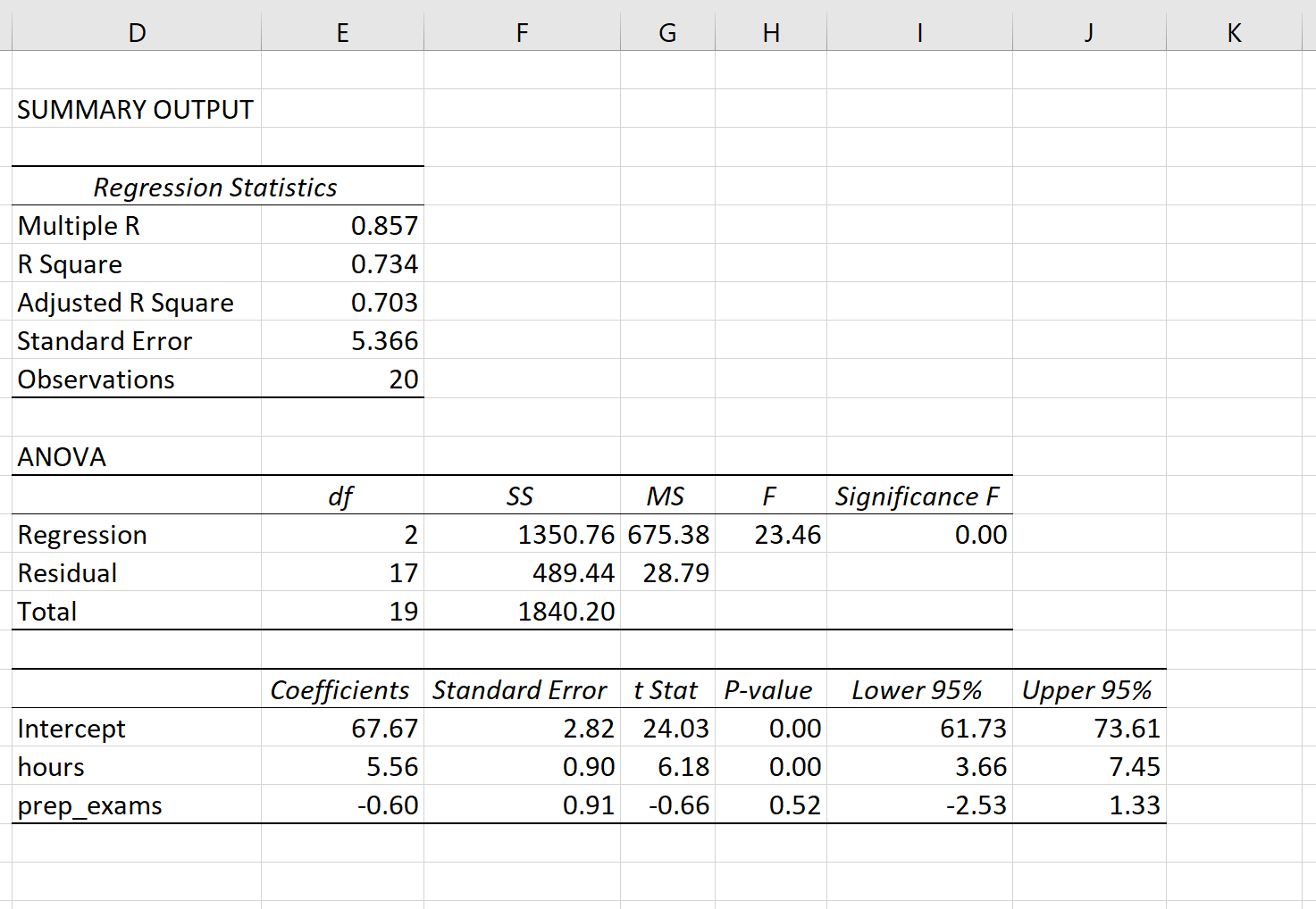SciTech-Mathmatics-Probability+Statistics: Assumptions, $\large P-value$, $\large overall\ F-value$ and $\large Null\ and\ Alternative\ Hypothesis$ for $\large Linear\ Regression\ Model$
Null and Alternative Hypothesis for Linear Regression
Linear regression is a technique we can use to understand the relationship between one or more predictor variables and a response variable.
To determine if there is a statistically significant relationship between a single predictor variable and the response variable, or to determine if there is a \(\large jointly\) statistically significant relationship between all predictor variables and the response variable, we need to analyze the \(\large overall\ F-value\) of the model and the corresponding \(\large P-value\).
if the \(\large P-value\) is less than .05, we can reject the \(\large NH\).
Assumptions of Linear Regression
For the results of a LR(Linear Regression) model to be valid and reliable,
we need to check that the following four assumptions are met:
- Linear relationship: There exists a linear relationship between the independent variable, x, and the dependent variable, y.
- Independence: The residuals are independent. In particular, there is no correlation between consecutive residuals in time series data.
- Homoscedasticity: The residuals have constant variance at every level of x.
- Normality: The residuals of the model are normally distributed.
If one or more of these assumptions are violated, then the results of our linear regression may be unreliable or even misleading.
Refer to this post for:
- an explanation for each assumption,
- how to determine if the assumption is met,
- what to do if the assumption is violated.
Abbreviations
- \(\large SLR\) : \(\large Simple\ Linear\ Regression\)
- \(\large MLR\) : \(\large Multiple\ Linear\ Regression\)
- \(\large NH\) : \(\large Null\ Hypotheses\)
- \(\large AH\) : \(\large Alternative\ Hypotheses\)
- \(\large NAH\) : \(\large Null\ and\ Alternative\ Hypotheses\)
SLR(Simple Linear Regression)
If we only have one predictor variable and one response variable, we can use SLR(Simple Linear Regression), which uses the following formula to estimate the relationship between the variables:
\(\large \hat{y} = \beta_0+ \beta_1 x\)
where:
- \(\large \hat{y}\) : The estimated response value.
- \(\large \beta_0\) : The average value of \(\large y\) when \(\large x\) is \(\large zero\).
- \(\large \beta_1\) : The average change in \(\large y\) associated with a one unit increase in \(\large x\).
- \(\large x\) : The value of the predictor variable.
\(\large SLR\) uses the following \(\large NAH\):
- \(\large H_0: \beta_1 = 0\)
- \(\large H_A: \beta_1 \neq 0\)
The \(\large Null\ Hypotheses\) states that the coefficient \(\large \beta_1\) is equal to zero.
In other words, there is no statistically significant relationship between the predictor variable, \(\large x\), and the response variable, \(\large y\).The \(\large Alternative\ Hypotheses\) states that the coefficient \(\large \beta_1\) is not equal to zero. In other words, there is a statistically significant relationship between the predictor variable, \(\large x\), and the response variable, \(\large y\).
MLR(Multiple Linear Regression)
If we have multiple predictor variables and one response variable, we can use MLR(Multiple Linear Regression), which uses the following formula to estimate the relationship between the variables:
\(\large \hat{y} = \beta_0+ \beta_1 x_1 + \beta_2 x_2 + \cdots + \beta_k x_k\)
where:
- \(\large \hat{y}\) : The estimated response value.
- \(\large \beta_0\) : The average value of \(\large y\) when all predictor variables are equal to \(\large zero\).
- \(\large \beta_i\) : The average change in \(\large y\) associated with a one unit increase in \(\large x_i\).
- $\large x_i $ : The value of the predictor variable $\large x_i $.
\(\large MLR\) uses the following \(\large NAH\):
- \(\large H_0: \beta_1 = \beta_2 = \cdots = \beta_k = 0\)
- \(\large H_A: \beta_1 = \beta_2 = \cdots = \beta_k \neq 0\)
The \(\large NH\) states that all coefficients in the model are equal to zero.
In other words, none of the predictor variables $\large x_i $ have a statistically significant relationship with the response variable, \(\large y\).The \(\large alternative\ hypotheses\) states that not every coefficient is \(\large simultaneously\) equal to zero.
The following examples show how to decide to reject or fail to reject the \(\large NH\) in \(\large \text{ both }SLR \text{ and }MLR\) models.
Example 1: SLR(Simple Linear Regression)
Suppose a professor would like to use the number of hours studied to predict the exam score that students will receive in his class. He collects data for 20 students and fits a simple linear regression model.
The following screenshot shows the output of the regression model:

The fitted \(\large SLR\) model is:
$ Exam\ Score = 67.1617 + 5.2503*(hours\ studied)$
To determine if there is a statistically significant relationship between hours studied and exam score, we need to analyze the \(\large overall\ F-value\) of the model and the corresponding \(\large P-value\):
- \(\large Overall\ F-Value\) : 47.9952
- \(\large P-value\) : 0.000
Since this \(\large P-value\) is less than .05, we can reject the \(\large NH\).
In other words, there is a statistically significant relationship between hours studied and exam score received.
Example 2: MLR(Multiple Linear Regression)
Suppose a professor would like to use the number of hours studied and the number of prep exams taken to predict the exam score that students will receive in his class. He collects data for 20 students and fits a multiple linear regression model.
The following screenshot shows the output of the regression model(\(\large MLR\) output in Excel):

The fitted \(\large MLR\) model is:
\(Exam\ Score = 67.67 + 5.56*(hours\ studied) – 0.60*(prep\ exams\ taken)\)
To determine if there is a \(\large jointly\) statistically significant relationship between the two predictor variables and the response variable, we need to analyze the \(\large Overall\ F-Value\) of the model and the corresponding \(\large P-value\):
- \(\large Overall\ F-Value\) : 23.46
- \(\large P-value\) : 0.00
Since this \(\large P-value\) is less than .05, we can reject the \(\large NH\).
In other words, hours studied and prep exams taken have a jointly statistically significant relationship with exam score.
Note: Although the \(\large P-value\) for prep exams taken (p = 0.52) is not significant, prep exams combined with hours studied has a significant relationship with exam score.
Additional Resources
Understanding the F-Test of Overall Significance in Regression
How to Read and Interpret a Regression Table
How to Report Regression Results
How to Perform Simple Linear Regression in Excel
How to Perform Multiple Linear Regression in Excel
随机推荐
- 银河麒麟系统 jenkins docker 部署 自动化打包部署git 项目
Jenkins 是一个开源的自动化服务器,主要用于实现 持续集成(CI) 和 持续交付/部署(CD),其核心作用在于通过自动化流程提升软件开发和交付的效率与质量 一.环境准备 1. 安装 Docker ...
- 各式各样的console
目录 知乎的console 百度的console B站的console 知乎的console 我很喜欢hire的文字样式. _____ _____ _____ _____ /\ \ /\ \ /\ \ ...
- 卢卡斯(lucas)定理
对于质数 \(p\),有 \[{\Large \begin{aligned} & \binom{n}{m} \equiv \binom{\left \lfloor n/p \right \rf ...
- 模板导入_分页_cookie_装饰器_实例
程序目录 urls.py """s14_day21 URL Configuration"""from django.contrib impo ...
- Python模块的搜索路径
在Python中,模块搜索路径是指解释器用来查找导入模块的位置列表.了解和掌握Python模块搜索路径对于正确导入模块和管理模块的位置至关重要. Python模块搜索路径的主要来源包括当前目录.Pyt ...
- 探索Rust:深入了解结构体和枚举的用途与高级功能
@charset "UTF-8"; .markdown-body { line-height: 1.75; font-weight: 400; font-size: 15px; o ...
- C# system.Threading.Timer和system.Timers中的定时器
它们都可以用于在指定时间间隔后执行代码.然而,它们在实现和用法上有一些差异. System.Threading.Timer: System.Threading.Timer 是基于线程的定时器,它属于 ...
- protobuf 'NoneType' object has no attribute 'message_types_by_name'
最近爬一个网站,用的protobuf协议,报错查了半天.报错'NoneType' object has no attribute 'message_types_by_name',最后是因为protob ...
- AI编码焕新:用Context7
最近,一款名为 Context7 MCP 的工具备受瞩目.网络上流传着各种说法,比如它解决了大语言模型的痛点.革新了 AI 编码方式,甚至能让 Cursor 效率提升十倍.那么,Context7 真有 ...
- SAP发布简易REST 三:API平台之接口文档
为了完善API接口,增强友好性,做了一点小文档展示. 新建配置表:(用来做接口参数配置展示使用,不在程序中应用) 因为需要给每个接口一个对应的名字,所以在原来的API控制表中增加一个文本字段. 这里加 ...
